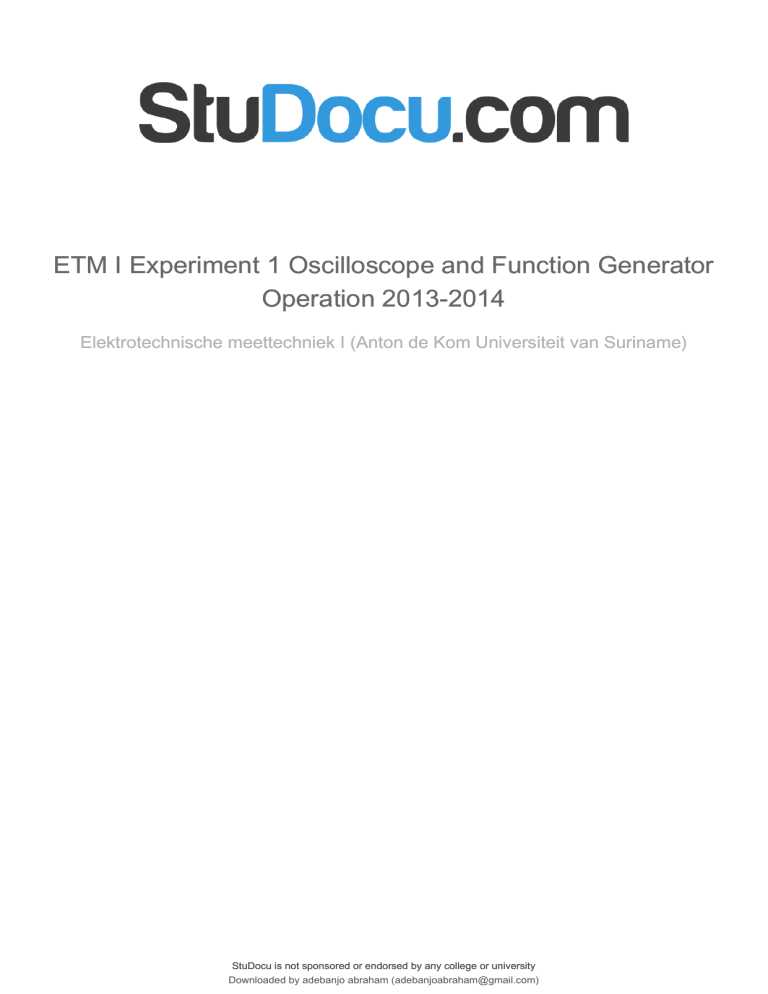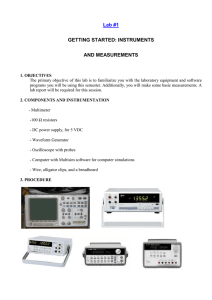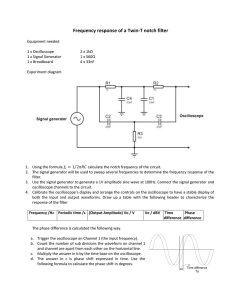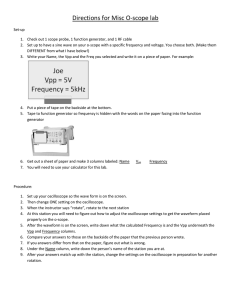
lOMoARcPSD|4485134
ETM I Experiment 1 Oscilloscope and Function Generator
Operation 2013-2014
Elektrotechnische meettechniek I (Anton de Kom Universiteit van Suriname)
StuDocu is not sponsored or endorsed by any college or university
Downloaded by adebanjo abraham (adebanjoabraham@gmail.com)
lOMoARcPSD|4485134
Name
Date
Instructor
EXPERIMENT
Oscilloscope
and Function
Generator
Op"ration
OBJECTIVE
To use the oscilloscope and function generator to calculate, obtain, and
durations (periods) of uarious uoltage signals.
aleasttrre the amplitudes and
EQIIIPMENT REQUIRED
lnstruments
Oscilloscope
Digital multimeter
Supplies
(1) 1.5-V D cell and holder
Function generator
EQUIPMENT ISSUED
Downloaded by adebanjo abraham (adebanjoabraham@gmail.com)
lOMoARcPSD|4485134
Exp. 1 / Oscilloscope and Function Generator Operation
IME OF THEORY
Oscilloscope
The oscilloscope is the most important instrument available to the practicing
technician or engineer. It permits the visual display of a voltage signal that
can reveal a range of information of the operating characteristics of a circuit
or system that is not available with a standard multimeter. At first glance
the instrument may appear complex and difficult to master. Be assured,
however, that once the function of each section of the oscilloscope is
explained and understood and the system is used throughout a set of
experiments, your expertise with this important tool will develop quite
rapidly.
In addition to the display of a signal, it can also be used to measure the
average value, rms value, frequency, and period of a sinusoidal or nonsinusoidal signal. The screen is divided into centimeter divisions in the vertical
and horizontal directions. The vertical sensitivity is provided (or set) in
volts/div., while the horizontal scale is provided (or set) in t time (s/div.). If a
particular signal occupies 6 vertical divisions and the vertical sensitivity is 5
mV/div., the magnitude of the signal can be determined from the following
equation:
Amplitude of signal voltage = voltage sensitivity (V/div.) x deflection (div.)
(1.1)
% = (5 mV/div.) (6 div.) = 30 mV
If
one cycle of the same signal occupies 8 divisions on the horizontal
scale with a horizontal sensitivity of 5 ps/div., the period and frequency of
the signal can be determined using the following equations:
Period of signal voltage = horizontal sensitivity (s/div.) x deflection (div.)
(1.2)
? = (5 ps /div.) (8 div.) = 40 ps
andf=+
=
40 ps
=251<TIz
Function Generator
The function generator is a voltage supply that typically provides a
sinusoidal, square-wave, and triangular voltage waveform for a range of
frequencies and amplitudes. The frequency and the amplitude of these
voltage functions can be set by the proper dial positions and their associated
multipliers. For more precise settings of these parameters, the oscilloscope is
used.
Both the scope and the function generator are built to withstand some
abuse, so do not be afraid to try various combinations of dial settings to fully
develop your abilities with this laboratory experiment. If you are working in
a group, every group member should be involved in the experimental work. It
is important to learn how to use the laboratory equipment, such as the
function generator and the oscilloscope, properly. Such acquired skills are
of the electrical engineer and technician.
for thebyjob
essential
Downloaded
adebanjo abraham (adebanjoabraham@gmail.com)
.
lOMoARcPSD|4485134
Exp.
l/Procedure
g
PROCEDURE
Part
1. The Oscilloscope
The instructor will provide a brief description of the various sections of the
oscilloscope and function generator. In your own words, describe the function
and use of each of the following controls or sections of the oscilloscope.
a.
Focus ofvoltage trace:
b.
Intensity of voltage trace:
c.
Vertical and horizontal position controls:
d.
Vertical sensitivity:
e.
Horizontalsensitivity:
f.
Vertical mode selection:
g.
AC-GND-DC switch:
h.
Beamfinder:
i.
Calibrate switches:
j.
Internal
k
Trigger section:
l.
External trigger input:
sJrnc:
Downloaded by adebanjo abraham (adebanjoabraham@gmail.com)
lOMoARcPSD|4485134
Exp. 1 / Oscilloscope and Function Generator Operation
m. Input
n.
Part
2.
resistance and capacitance:
Probe:
The Function Generator
Setup
a.
b.
c.
Turn on the oscilloscope and adjust the necessary controls to
establish a clear, bright, horizontal line across the center of the
screen. Adjust the various controls to see their effects on the
display.
Connect the function generator to one vertical channel of the
oscilloscope and set the output of the generator to a 1000 Hz
sinusoidal waveform.
Set the vertical sensitivity of the scope to 1 V/div. and adjust the
amplitude control of the function generator to establish a 4 V
peak-to-peak (p-p) sinusoidal waveform on the screen.
Horizontal Sensitivity
d.
e.
Determine the period of the 1000 Hz sinusoidal waveform in
milliseconds using the equation ? = Uf. Show all work for each
part of the experiment. Be neat!
? (calculated) =
Set the horizontal sensitivity of the scope ta 0.2 ms/div. Using the
results of Part 2(d), predict and calculate the number of horizontal
divisions required to properly display one full cycle of the 1000 Hz
signal.
Number of divisions (calculated) =
Using the oscilloscope, measure the number of required divisions
and insert below. How does the result compare to the calculated
number of divisions?
Number of divisions (measured) =
Change the horizontal sensitivrty of the oscilloscope to 0.5 ms/div.
without touching any of the controls of the function generator.
Using. the results of Part 2(d), how many horizontal divisions will
now be required to display one full cycle of the 1000 Hz signal?
Number of divisions (calculated) =
Downloaded by adebanjo abraham (adebanjoabraham@gmail.com)
lOMoARcPSD|4485134
Exp.
1
/ Procedure
5
Using the oscilloscope, measure the number of required divisions
and insert below. How does the result compare to the calculated
number of divisions?
g.
Number of divisions (measured) =
Change the horizontal sensitivity of the oscilloscope to 1 ms/div.
without touching any of the controls of the function generator.
Using the results of Part 2(d), how many horizontal divisions will
now be required to display one full cycle of the 1000 Hz signal?
Number of divisions (calculated) =
Using the oscilloscope, measure the number of required divisions
and insert below. How does the result compare to the calculated
number of divisions?
h.
Number of divisions (measured) =
What was the effect on the appearance of the sinusoidal waveform
as the horizontal sensitivity was changed from 0.2 ms/div. to
0.5 ms/div. and finally to 1ms/div.?
Did the frequency of the signal on the screen change with each
horizontal sensitivity? What conclusion can you draw from the
results regarding the effect of the chosen horizontal sensitivity on
the signal output of the function generator?
i.
Given a sinusoidal waveform on the screen, review the procedure
to determine its frequency- Develop a sequence of steps to
calculate the frequency of a sinusoidal waveform appearing on the
Jscreen of an oscilloscope.
Downloaded by adebanjo abraham (adebanjoabraham@gmail.com)
lOMoARcPSD|4485134
Exp. 1 / Oscilloscope and Function Generator Operation
Vertical Sensitivity
j.
k.
Do not touch the controls of the function generator but set the
sensitivity of the scope to 0.2 ms/div. and set the vertical
sensitivity to 2 V/div. Using this latter sensitivity, calculate the
peak-to-peak value of the sinusoidal waveform on the screen by
first counting the number of vertical divisions between peak
values and multiplying by the vertical sensitivity.
Peak-to-peak value (calculated) =
Change the vertical sensitivity of the oscilloscope to 0.5 V/div. and
repeat Part 2(i).
Peak-to-peak value (calculated) =
What was the effect on the appearance of the sinusoidal waveform
as the vertical sensitivity was changed from 2Y/div. to 0.5 V/div.?
Did the peak-to-peak voltage of the sinusoidal signal change with
each vertical sensitivity? What conclusion can you draw from the
results regarding the effect of changing the vertical sensitivity on
the output signal of the function generator?
Can the peak or peak-to-peak output voltage of a function
generator be set without the aid of an auxiliary instrument such
as an oscilloscope or DMM? Explain.
Part
3. Exercises
a. Make all the necessarJr a{ustments
6 Vn-n
to clearly display a 5000-Hz
sinusoidal signal on the oscilloscope. Establish the zero volt
line at the center of the screen.
Record the chosen sensitivities:
Vertical sensitivity =
Horizontal sensitivity =
Draw the waveform on Fig. 1.1, carefully noting the required
number of horizontal and vertical divisions. Add vertical and
horizontal dimensions to the waveform using the chosen sensitivities by
listed
above.
Downloaded
adebanjo
abraham (adebanjoabraham@gmail.com)
lOMoARcPSD|4485134
Exp. 1 / Procedure
0v
Figure 1-1
Calculate the period of the waveform on the screen using the
number of horizontal divisions for a full cycle as shown.
b.
? (calculated) =
Repeat Part 3(a) for a 200-Hz 0.8 Vo-n sinusoidal waveform on Fig.
r.2.
Vertical sensitivity =
Horizontal sensitivity =
? (calculated)
=
OV
Figure 1-2
Repeat Part 3(a) for a 100-kHz 4 Vn-o square wave on Fig. 1.3.
Note that a square wave is called for.
Vertical sensitivity =
Horizontal sensitivity =
? (calculated) =
Downloaded by adebanjo abraham (adebanjoabraham@gmail.com)
lOMoARcPSD|4485134
Exp. 1 / Oscilloscope and Function Generator Operation
0v
Figure 1-3
Part 4. Effect of DC Levels
a.
Reestablish the l--kHz 4 Vo-n sinusoidal waveform on the screen.
Calculate the effective value of the sinusoidal waveform.
7"-"
b.
c.
(calculated) =
Disconnect the function generator from the scope and measure the
effective (rms) value of the output of the function generator using
the digital meter.
Vr-, (measured) -
Determine the magnitude of the percent difference between the
calculated and measured levels using the following equation:
I Vtcatcl
7o
d.
Different"
-
Vt*"url
=l vr.",.l
I
I
x
Loovo
ToDifference =
Reconnect the function generator to the scope with the l-kHz
4 Vn-o signal and switch the AC-GND-DC coupling switch of the
vertical channel to GND. What is the effect?
Why? How can this scope function be used?
Downloaded by adebanjo abraham (adebanjoabraham@gmail.com)
lOMoARcPSD|4485134
Exp.
1
I
/ Procedure
e.
Now move the AC-GND-DC coupling switch to the AC position.
What is the effect on the screen display? Why?
Finally, move the AC-GND-DC coupling switch to the DC position.
What is the effect on the screen display (if any)? Why?
g.
Construct the input of u; of Fig. 1.4 by placing a D cell in series
with the output of the function generator. Be sure the ground of
the oscilloscope is connected directly to the ground of the function
generator. Measure and record the actual battery voltage using
the DC mode of the DMM.
DC level (measured) =
+
1.5
*f*rs
V
vi
V
1.5
D cell (E
",urt
=
v
)
I
Function
generator
6;
I
-
:
Figure 1-4
h. Apply the input voltage u; of Fig. 1.4 to one channel of the
oscilloscope with the AC-GND-DC coupling switch in the GND
position and set the resulting horizontal line (zero reference level)
in the middle of the screen. Then move the AC-GND-DC coupling
switch to the AC position and make a rough sketch of the
waveform on Fig. 1.5, clearly showing the zero reference line and
the number of vertical and horizontal divisions. Using the chosen
sensitivities, label the magnitudes of the various horizontal and
grid lines.(adebanjoabraham@gmail.com)
vertical
Downloaded by adebanjo abraham
lOMoARcPSD|4485134
Exp. 1 / Oscilloscope and Function Generator Operation
0v
Figure 1-5
i.
Switch the position of the AC-GND-DC coupling switch to the DC
mode and make a rough sketch of the resulting waveform on Fig.
1.6, including the detail requested in Part 4(h).
OV
Figure
1€
Did the vertical shift of the sinusoidal waveform equal the DC
voltage of the battery?
Is the shape of the sinusoidal waveform changed by moving the
AC-GND-DC coupling switch through the various positions?
j.
Reverse the polarity of the battery of Fig. 1.4 and repeat Parts 4(h)
and (i). Observe the effect on the waveform in the AC and DC
modes-and comment below.
Downloaded by adebanjo abraham (adebanjoabraham@gmail.com)
lOMoARcPSD|4485134
Exp. 1 / Part 5. Problems
11
Part
5. Problems
1. Given u = 20sin2000f,
a.
determine
c)
b.f
c.T
2.
d.
Peak value
e.
Peak-to-peak value
f.
Effective value
g.
DC level
Given u = 8 x
a.f
b.
1F
sin 2n4O0Ot, determine
o)
c.T
d. Peakvalue
e. Peak-to-peakvalue
f.
Effective value
Downloaded by adebanjo abraham (adebanjoabraham@gmail.com)
lOMoARcPSD|4485134
Exp.
g.
3.
1
/ Oscilloscope and Function Generator Operation
DC level
Given Vr-. = L.2 Y and a frequency of 400 Hz, determine the
mathematical expression for the sinusoidal voltage as a function of
time.
Downloaded by adebanjo abraham (adebanjoabraham@gmail.com)





